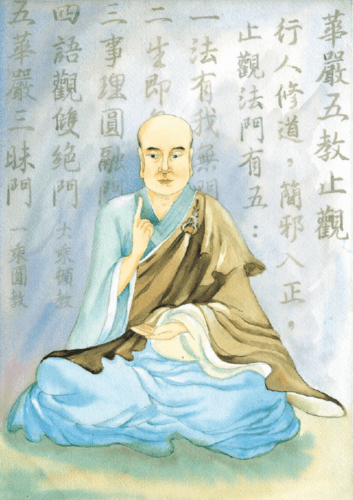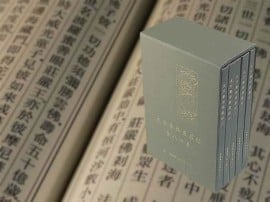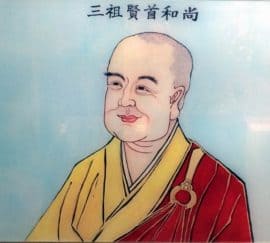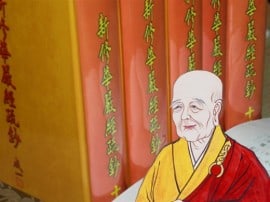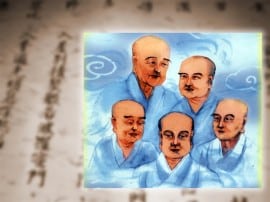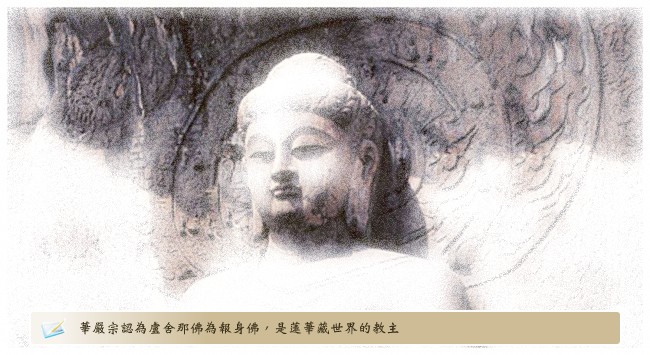
華嚴宗源流與傳承概況
A Historical Overview of the Huayen School
本蓮社以「華嚴」立名,所宗奉者為華嚴宗,茲先簡介華嚴宗源流,後述當代之繼承與開拓。
The Huayen Lotus Society (HLS, Taipei) & Avatamsaka Buddhist Lotus Society (ABLS, USA) take their names from the Huayen School & Avatamsaka Sutra, on the basis of which HLS & ABLS were founded. Therefore, a brief history of the Huayen School will be introduced firstly, followed by the succession of the HLS and its contemporary development.
一、華嚴宗源流
The Origin and Development of the Huayen School
華嚴宗乃我國佛教八大宗派之一,以《大方廣佛華嚴經》為一宗正依之根本經典,故名「華嚴宗」;以其大成於法藏.賢首國師 (643-712),故名「賢首宗」;全經以彰顯一真法界為主旨,故亦名「法界宗」;澄觀.清涼國師 (738-839) 著《華嚴經疏》及《演義鈔》,發揮華嚴精義,故一名「清涼宗」。茲以崇重根本,故仍名「華嚴宗」。
As one of eight major schools in Chinese Buddhism, the Huayen School is named after the title of Avatamsaka Sutra, pronounced Huayen Jing in Chinese, which is the principle scripture of the school. Founded by Master Dushun (557-640), the teachings of the Huayen School were spread by the Great Master Fazang (643-712), aka “Royal Mentor XianShou,” who systematized the Huayen philosophy in Tang dynasty. So, it was also called the Xianshou School.
Since the purport of the Avataṃsaka Sūtra is the revelation of the Dharmarealm of the one reality, it is also known as the Dharma Realm School as well. It can be referred to the Chingliang School, named after Chengguan (738-839), aka “Royal Mentor Chingliang,” who elaborated on the essentials of Huayen philosophy in his massive Commentaries and Sub-commentaries to the Avataṃsaka Sūtra. Due to the great reverence for its foundational scripture Huayen Sutra, the name of Huayen School is used in general.
依《大智度論》說,諸大乘經多是文殊師利菩薩之所結集。《華嚴經》為諸大乘經之首,當亦不能例外。釋迦牟尼佛 (623-543 B.C.E.) 滅度而後,賢聖隨隱,外道競興,世無大乘根器。《華嚴經》隱而不傳者六百餘年。迨龍樹菩薩 (150-250) 出世,《華嚴經》方始流傳人間。
According to the Great Treatise on Transcendental Wisdom, most Mahāyāna sūtras were compiled by Bodhisattva Mañjuśrī, and the Avataṃsaka Sūtra in particular. However, this scripture had not been known for six hundred years after Sakyamuni Buddha (623-543 B.C.E.) passed away because nobody endowed with the natural capacity of Mahayana Vehicle at the time. It was not until Nāgārjuna (150-250) appeared in the world that the Avataṃsaka Sūtra began to circulate extensively.
《華嚴經》由龍樹菩薩自龍宮誦出,並由佛陀跋馱羅 (359-429)、實叉難陀 (652-710) 先後譯成華文;若論本宗遠祖,當推龍樹。更有以馬鳴 (100-160)、龍樹,以及杜順等五大師而稱七祖者。但以宏傳《華嚴》為業,並有著作以發揮其精義,且為習慣上所共同認定的「華嚴五祖」,是本宗之正統傳承。
It was told that the Avataṃsaka Sūtra was retrieved by Nāgārjuna from the Dragon king’s palace at the bottom of the sea. The Sutra was translated into Chinese once by Buddhabhadra (359-429) and later by Śikṣānanda (652-710). Therefore, the Huayen tradition can be traced back to Nāgārjuna.
Some people acknowledge Aśvaghoṣa (100-160), Nāgārjuna, and the five Chinese masters, Dushun杜順, descending to Zhiyan智儼 (602-668), Xianshou Fazang賢首法藏, Chingliang Chengguan清涼澄觀, and Guifeng Zongmi圭峰宗密 (780-841), as seven patriarchs of the Huayen School.
However, the orthodox Huayen lineage consists of its five great Chinese masters, who are generally recognized by tradition as the “Five Patriarchs of the Huayen School” because they devoted themselves to the promotion of the Avataṃsaka Sūtra and expounded its profound doctrines in their works.
初祖杜順和尚,根據《華嚴經》作《華嚴法界觀門》(即:法界三觀),以周遍含容之理,顯事事無礙之境;並述《華嚴五教止觀》,在各宗之觀法中,允稱獨步。
The First Huayen Patriarch Ven. Master Dushun innovated the three contemplations of the dharmarealm (Chn. Huayen Fajie Sanguan) based on the Avataṃsaka Sūtra. He revealed the unimpeded interpenetration between all phenomena with the principle of total pervasion and accommodation for Huayen practice on his discourses, Contemplation of the Dharmarealm According to Huayen Sūtra (Chn. Huayen Fajie Guanmen) and Meditation and Contemplation According to the Five Classifications of The Teachings of Huayen (Chn. Huayen Wujiao Zhiguan). This threefold contemplation and fivefold teachings are outstanding among the methods of contemplation of all Buddhist schools.
二祖雲華和尚,法名「智儼」,又稱「至相尊者」,根據《六十華嚴經》作《搜玄記》,發明十重玄門,以總相、別相、同相、異相、成相、壞相之六相而混融之。更草創五教,為賢首國師判教之張本。
The Second Patriarch Ven. Master Yunhua, aka “Great Master Zhixiang,” who is commonly known by his Dharma name Zhiyan, composed the Notes on Fathoming the Profundities of the Avataṃsaka Sūtra (Chn. Huayen Jing Souxuan Ji) by commenting on the sixty-roll translation of the Avataṃsaka Sūtra. He elaborated the Ten Mysterious Gates and the interfusion of the Six Aspects of all phenomena—whole and part, identity and difference, integration and disintegration. He also drew up the five classifications of the Buddha’s teachings, paving the way for Fazang’s establishment of the Huayen doctrinal taxonomy.
三祖賢首國師,法號「法藏」,根據《搜玄記》更作《探玄記》二十卷。又作《華嚴一乘教義分齊章》,判釋迦如來一代所說之教典為三時、五教,以華嚴之法界緣起、事事無礙為別教一乘,最為尊特。五教之規模至此已趨為完整。
The Third Patriarch Xianshou, aka Fazang by the Dharma name, composed the Commentaries on the Avataṃsaka Sūtra, i.e. the Notes on Exploring the Profundities of the Avataṃsaka Sūtra (Chn. Huayen Jing Tanxuan Ji) in twenty rolls based on Zhiyan’s Fathoming the Profundities.
He also composed the Treatise on the Classification of the Doctrines of the One Vehicle of Huayen (Chn. Huayen Yisheng Jiaoyi Fenqi Zhang) and classified Buddhist scriptures into three periods and five characteristics of Śākyamuni Buddha’s teaching. According to his schema in this system, Huayen doctrines of the interdependent co-arising of the dharmarealm and unimpeded interpenetration between all phenomena became the most distinguished teaching of the One Vehicle (Ekayāna). In the meantime, Huayen’s fivefold doctrinal taxonomy was pretty highly developed by Fazang.
四祖清涼國師,法號「澄觀」,作《華嚴懸談》、《華嚴疏鈔》,總括大、小乘、性、相、空、有,包羅萬象,不倚不偏;於華嚴要義,已發揮殆盡。華嚴宗之標識,如杲日在天,有目共睹。
The Fourth Patriarch Ven. Master Chengguan wrote Discourses on Huayen (Chn. Huayen Xuantan) and Commentaries and Sub-commentaries on the Avataṃsaka Sūtra (Chn. Huayen Shuchao), which are unbiased and all-embracing — including Mahāyāna and Śrāvakayāna, Dharma-nature and Dharma-characteristics, emptiness and existence. He explored the essential Huayen doctrines to the full, making the Huayen School in the spotlight as a prestigious tradition.
五祖圭峰宗密大師,祖述清涼,教禪並重。大師得力於《圓覺》一經。所作之《圓覺經》大小《疏鈔》,其思想體系,皆與清涼一貫。本宗至此,基礎鞏固。
The Fifth Patriarch Ven. Master Zongmi, also commonly referred to the monastic title of Guifeng, followed the footsteps of Chengguan and put emphasis on the fundamental congruence of the doctrinal and practical approaches, which means the distinction between doctrinal and practical strains of Buddhism is artificial.
Zongmi was inspired by the Sutra of Perfect Enlightenment (Chn. Yuanjue Jing). His thinking, as shown in his Commentary and Sub-commentary on the said Sutra, is consistent with that of Chengguan. His philosophy was profoundly impacted by Chengguan and fundamentally continued the lineage of the Huayen tradition. By the time, the solid foundation of the Huayen School has been completely established by the five Patriarchs.
唐武宗會昌法難 (845) 之際,佛教門庭飽受摧殘,包括華嚴宗在內的各大宗門式微,佛教義學思想發展停滯。
In the year 845 AD, the Huichang Persecution of Buddhism was initiated by Tang Emperor Wuzong. The persecution lasted for less than 2 years but Buddhism in China was hardly like before. Traditional Buddhist systematic doctrinal studies and teachings, including the Huayen School, had diminished afterward for long.
逮至北宋長水子璿 (965-1038) 為報佛恩,勵志扶持久衰不振的華嚴宗,專就華嚴教觀深究其奧旨,依賢首教,疏《楞嚴經》,以此開導僧俗;同時,亦主張「教禪一致」,契合宗密思想,華嚴法脈賴以不墜。
It was not until in Song dynasty, Ven. Zixuan (965-1038) determined to revive the Huayen tradition in gratitude for the Buddha. He focused on investigating Huayen doctrines and practice, and composed the twenty-fascicle Notes on the Śūraṅgama Samādhi Sūtra based on Huayen teaching tradition to influence monks and lay people. He also promoted the fundamental congruence of the doctrinal and practical approaches, which resonated with Zongmi’s thoughts. Therefore, the lineage of Huayen School kept up without interruption.
其徒晉水淨源 (1011-1088) 繼之而起,振興華嚴宗風,久已散佚的《華嚴經疏鈔》,因高麗僧統義天 (1055-1101) 持來咨決所疑,得以復傳於神州大陸,時人稱為「中興教主」;現存《法界觀門助修記》、《金師子章雲間類解》、《華嚴妄盡還源觀疏鈔補解》、《華嚴經疏註、科》、《華嚴原人論發微錄》、《華嚴普賢行願修證儀》等華嚴義學著作。
Ven. Jinshuis Jingyuan (1011-1088), Zisuan’s disciple, followed his teacher’s steps and carried on promoting the Huayen Scholl. While he was at the Huiyin Temple 慧因寺, the Goryeo monks Daegak Guksa Uicheon (1055-1101) came to study under him, bringing along the long-lost Commentaries on the Huayen Sutra. These Dharma treasures were once again circulated in China. And Ven. Jinshui Jingyuan was considered to be the key figure of Huayen revival at the time. He is so called the patriarch of Huayen revival.
Based on the lost commentaries, Jingyuan filled the gap of traditional Buddhist systematic doctrinal studies and teachings, which has been interrupted in the Huichang Persecution, by considerable studies. His writings include Explication on the Contemplation of the Dharmarealm based on the Avataṃsaka Sūtra, Discourse of the Essay on the Golden Lion, Supplemental Commentary on the Contemplation of the profound truth of Huayen practice, eliminating delusions, and awakening the Buddha nature, Notes and Comments on the Commentaries on the Avataṃsaka Sūtra, Record of the Treatise on Inquiry into the Origin of Humanity of Huayen, the Huayen practice and cultivation Ritual of the Conduct and Vows of Bodhisattva Samantabhadra, and some other texts on Huayen thoughts.
繼二水後,兩宋期間《一乘教義分齊章》注釋者中,有道亭Daoting、師會Shihui (1102-1166)、觀復Guanfu和希迪Xidi四人,被後世尊為「宋代華嚴四大家」。
Later in Song Dynasty, there were four monks named Daoting, Shihui (1102-1166), Guanfu, and Xidi making Notes on the Fazang’s Treatise on the Classification of the Doctrines of the One Vehicle of Huayen. They are respectfully called Huayen Four Great Masters in Song dynasty.
元代普瑞大師會集澄觀《大疏》、《演義鈔》、《懸談》諸疏等,編著《華嚴懸談會玄記》,並彙編《華嚴經海印道場懺儀》,乃集宋、元兩代華嚴之大成。
During the Yuan dynasty Master Purui compiled Notes on Collecting the Profundities of the Discourse on Huayen (Chn. Huayen Xuantan Huixuan Ji) from Chengguan’s Commentaries, Sub-Commentaries, Discourses on the Avataṃsaka Sūtra, and other exegetical works. He also composed Repentance Ritual of the Ocean Seal Bodhimaṇḍa Where Buddha’s Practice Is Carried out Based on the Avataṃsaka Sūtra (Chn. Huayen Jing Haiyin Daochang Chanyi). Purui’s work is a comprehensive synthesis of the Huayen studies in the Song and Yuan dynasties.
明代憨山德清大師 (1546-1623) 撰《華嚴綱要》,並有蓮池袾宏 (1535-1615,華嚴雲棲法系)、三懷洪恩 (1545-1608,華嚴雪浪法系)、不夜照燈 (1604-1682,賢首寶通法系)、高原明昱 (1544?-1633?,賢首兼慈恩法系) 等明代四大華嚴宗傳法系人,闡揚華嚴宗旨,弘通華嚴思想教義。
In Ming dynasty Master Hanshan Deqing authored the Essentials of Huayen (Chn. Huayen Gangyao). In this period there were also four major Huayen lineages. The Representatives of these lineages include Lianchi Zhuhong (1535-1615, the Yunqi lineage), Sanhuai Hongen (1545-1608, the Xuelang lineage), Buye Zhaodeng (1604-1682, the Xianshou Baotong lineage), and Gaoyuan Mingyu (1544?-1633?, the Xianshou and Cien lineage). They all expounded the central tenets of the Avataṃsaka Sūtra and promoted the doctrines and practice of Huayen tradition.
傳至清代,柏亭續法 (1641-1728) 深研杜順、法藏、澄觀祖師之義學思想,並大力弘揚華嚴教法、組織華嚴宗教觀體系,著如《賢首五教儀》、《五教儀科注》、《賢首五教儀開蒙》、《賢首五教斷證三覺揀濫圖》、《法界宗五祖略記》及《華嚴宗佛祖傳》等作品,其傳法弟子有培豐、慈裔、正中、天懷等二十餘人。另有通理法師,著《五教儀開蒙增註》等,傳承未泯。
During the Qing dynasty Master Boting Xufa (1641-1728) studied the philosophies of Dushun, Fazang, and Chengguan in depth. He strongly propagated the teachings of Huayen tradition and developed the comprehensive system of Huayen doctrines and practice.
His writings include the Outline of the Xianshou Fivefold Teachings (Chn. Xianshou Wujiaoyi), Commentary on the Outline of the Fivefold Teachings Based on Its Textual Organization (Chn. Wujiaoyi Kezhu), Primer on the Outline of the Xianshou Fivefold Teachings (Chn. Xianshou Wujiaoyi Kaimeng), Analysis Diagrams of the States of Awakening to the Buddha Nature while Eliminating Delusion at the Three Stages of Enlightenment in the Xianshou Fivefold Teachings (Chn. Xianshou Wujiao Duanzheng Sanjue Jianlantu), Biographical Sketches of the Dharma Realm School’s Five Patriarchs (Chn. Fajiezong Wuzu Lueji), and Transmission of All the Buddhist Doctrine, Practice, Teachings, and Lineages of the Buddha and the Patriarchs in the Huayen Tradition (Chn. Huayenzong Fozuzhuan).
He had more than twenty dharma heirs, including Ven. Peifeng (1681-1751), Ven. Ciyi, Ven. Zhengzhong, and Ven. Tianhuai. Moreover, Master Tongli wrote a Commentary on Master Xufa’s Primer on the Outline of the Fivefold Teachings. The transmission of the Huayen lineage was preserved in this period.
民國初年(1913),有月霞 (1858-1917) 和應慈 (1873-1965) 二老,於滬上創建「華嚴大學」,學子有持松 (1894-1972)、常惺 (1896-1939)、智光 (1889-1963)、靄亭 (1893-1947)等,皆能領其宗旨。應慈法師創華嚴學會於上海,專講三譯《華嚴》,一時學子四聚,南亭 (1900-1982)、隆泉 (1902-1973)、靈源 (1902-1988) 等其傑出者。
Soon after the republican government of China replaced the Qing dynasty, Ven. Masters Yuexia (1858-1917) and Yingci (1873-1965) established Huayen University in Shanghai in 1913. Their founding philosophy was well realized by their students such as Chisong (1894-1972), Changxing (1896-1939), Zhiguang (1889-1963), and Aiting (1893-1947). Master Yingci also founded Huayen Association in Shanghai, where he focused his dharma talks on three major Chinese translations of the Avataṃsaka Sūtra. This association attracted many monastic students all across China, including distinguished ones such as Nanting (1900-1982), Longquan (1902-1973), and Lingyuan (1902-1988).
1949年大陸易幟,上海華嚴大學優秀學僧及後輩傳人諸師,承傳月霞、應慈二老「善弘華嚴」之教任,並隨時局因緣變遷,輾轉香江及寶島。堪稱近代振興華嚴宗的代表人物,而近現代華嚴宗之發展亦由此轉向嶄新的契機,華嚴教學的弘揚與法脈傳承之薪火,自此綿延不絕!
After the Chinese Civil War in 1949, many outstanding monastic students of Huayen University and dharma descendants of Huayen lineage move to Hong Kong and Taiwan. They inherited the mission “to promote Huayen” of Master Yuexia and Yingci at the turning point and keep the Huayen lineage without interruption. They are also regarded as monastic representatives of Huayen School in contemporary history. Since then, Huayen teachings have continued.
二、繼承與開拓
The Continuation and Expansion of the Huayen Lineage
1952年,南亭和尚創建台灣首座以華嚴為名的寺院,名「華嚴蓮社」。經智光、南亭二老,及成一和尚 (1914-2011) 、賢度法師 (1960-) 等幾代人的奮力耕耘下,華嚴聖教宣揚,宗門法脈薪傳。
In 1952 Ven. Master Nanting founded HLS, the first temple in Taiwan which went by the name “Huayen.” Several generations of abbots and abbesses, like Ven. Masters Zhiguang, Nanting, Chengyi (1914-2011), and Ven. Hsiendu (1960-), have put their efforts to promote the Huayen teachings and passed down the dharma lineage.
成一長老於西元1993年,首度在台復傳華嚴宗法脈,延續雲棲法系二十六傳蓮池袾宏大師、三十傳柏亭續法和尚一脈之薪火,由華嚴蓮社受法門人續演字號。三十一傳培豐憶敏,上海華嚴大學月霞和尚為三十二傳,華嚴大學首屆受業門生智光常法、寂祥常惺 (1896-1938) 等為三十三傳。
In 1993 Ven. Master Chengyi resumed the transmission of Huayen Sect in Taiwan for the first time, continuing the Yunqi lineage from Master Lianchi Zhuhong, the 26th generation, and from Master Xufa, the 30th generation. Hence, this lineage has been handed down to the monastic disciples of HLS. Master Peifeng Yimin was the 31st generation lineage holder. Master Yuexia, the founder of Shanghai Huayen University, was the 32nd generation. Zhiguang Changfa and Jixiang Changxing (1896-1938), the first-gen monastic graduates at Huayen University, were the 33rd generation.
自常惺法師下,再傳法嗣曇光清濟(南亭)為三十四傳,瑞定(成一)和尚接華嚴宗法為三十六傳,法名「聞虛」。
Ven. Master Changxing gave the transmission to his dharma heir Tanguang Qingji (Nanting) as the 34th generation. Ven. Master Ruiding (Chengyi) was the 36th generation lineage holder, with the Dharma name Wenxu.
今日華嚴蓮社所接續的華嚴宗法脈傳承,係根源於泰州光孝律寺常惺優祥和尚,故得於南亭和尚圓寂供讚「宗傳宣律,教演華嚴,戒乘俱急步前賢,道法廣流傳,興學濟貧,恩澤遍大千」,見曉近代律宗門庭兼繫華嚴法化傳承之情況。
The Huayen lineage transmission of HLS & ABLS is traced back to Ven. Master Changxing Youxiang of Guangxiao Vinaya Monastery in Taizhou (Jiansu, China). That is why in Ven. Master Nanting’s passing, the verse of praise said, “Inheriting the lineage from Nanshan Vinaya School and expounding the teachings of Huayen tradition, the Master followed the patriarchs’ footsteps, exerted great effort into the trainings of both discipline and wisdom and promoted the Buddha’s teachings far and wide. He provided education and helped the needy; his universal kindness extended to all beings.” It shows evidently in contemporary Chinese Buddhist history that the transmission of Huayen teachings is preserved in vinaya monasteries.
在華嚴蓮社、華嚴專宗學院、華嚴專宗研究所、國際華嚴研究中心等相繼成立、創辦後,從明代以降「兼弘賢首」轉向「專宗華嚴」的進路發展;而台北華嚴專宗學院的創辦,正是上海華嚴大學法統的延續,可謂華嚴大學在台復興。
By the establishment of HLS, the Taipei Huayen Buddhist College (THBC) and later its graduate school—the Huayen Institute of Buddhist Studies (HIBS), and International Centre for Huayen Studies (ICHS), the approach to cultivation and education has been shifted from “Huayen as part of the curriculum”, which had been adopted since the Ming dynasty, to “exclusive concentration on Huayen tradition.” All are founded to pass down the spirit of Shanghai Huayen University in Taiwan. Moreover, the educational goal has been transformed to exclusively focusing on Huayen Dharma tradition.
2014年,江蘇常熟興福寺方丈慧雲和尚 (1973- ) 秉承月霞老和尚「善弘華嚴」之遺訓,特地率團前來台北華嚴蓮社參訪,並向華嚴專宗學院暨研究所的豐碩成果請法、取經。
In 2014, Ven. Huiyun (1973- ), abbot of Xingfu Temple in Changshu, Jiansu, led a delegation to HLS in Taipei for a friendship visit. Proceeding the last will of Ven. Master Yuesxia to “Propagate the Huayen Tradition,” they aimed to share the extensive experiences of HLS, THBC, and HIBS.
此行雙方更簽署合作備忘錄,在月霞和尚致力弘揚華嚴宗派、創立華嚴大學及法界學院的基礎上,共同攜手延續華嚴法化之正統,共創華嚴弘化之願景,讓「華嚴本山」恢復其歷史定位、使命及價值。
During the visit, both parties signed a Memorandum of Understanding (MOU) based on Master Yuexia’s dedication to propagate the Huayen School tradition and to establish Huayen University and Dharma Realm College. In the future, they will work together to extend the traditional teachings of Huayen School. The goal is to restore Xingfu Temple’s historical role as the “Huayen Head Temple” while realizing its original missions and values established by Master Yuexia.
2015年,進行常熟興福寺「法界學院華嚴研究所」的首屆開班授課事宜,另有「百年華嚴回顧論壇」和「海峽兩岸聯合祭祖」等活動之開展,以期合力維持宗風於不墜。
In 2015, Changshu Xingu Temple initiated the first class of “Dharma Realm College and the Institute of Huayen Studies.” In addition, the activities like “Huayen: A Centennial Retrospective Symposium,” “Joint Cross-Strait Veneration of Past Huayen Patriarchs,” and many other events were organized in the same year in order to make concerted effort to retain the Huayen tradition.
華嚴蓮社自1952年創社至今,荷擔了中國近現代賢首聖教復興、宗門薪火傳衍之歷史使命。這一切的一切歸功於華嚴蓮社祖庭法系人,對於佛教革新、僧伽教育,以及華嚴法化弘傳,那份始終如一的熱忱與堅持。今專宗華藏莊嚴一脈而落地生根,並可預期在不久的將來,勢必進一步推動國際性華嚴法化與宗傳的發展態勢,清涼聖教於華嚴蓮社法系人之傳衍下,如日中天,光大普揚!
HLS has been carrying out the mission of reviving the Huayen teachings and continuing the dharma lineage transmission of the Huayen School in contemporary Chinese history since its establishment in 1952. Now it has put down roots of the Huayen tradition. All is credited to the unflagging enthusiasm and persistence of the generations of HLS’s lineage holders. They have showed the efforts for the Buddhist reform, the monastic education and the propagation of the Huayen teachings. The Huayen teachings is expected to continue to spread out globally and reach the peak like the sun at high noon.
歷史映象
